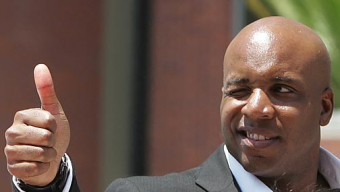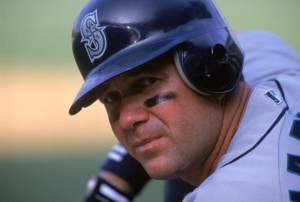Editor’s Note: All three golferswest.com writers, Bob Sherwin, Jim Street and Kirby Arnold, covered baseball for various newspapers long enough to earn the right to vote for Baseball’s Hall of Fame. This year is especially controversial with all the first-year players from the ‘steroids’ appearing on the ballot. The HOF announcement will be next Wednesday. Below is Jim Street’s perspective on his vote:
In all the years I have voted for the Hall of Fame — 30 and counting — this was the most difficult of ’em all.
I mean, how do you not vote for Barry Bonds (pictured above), the all-time Major League home-run leader? How do you not put a check in the box to the left of Roger Clemens’ name? And to a lesser extent, how about Sammy Sosa, who hit 60- something home runs more than anyone else in the game’s proud history? Or Mike Piazza, the God-son of Hall of Fame manager Tommy Lasorda and one of the best catchers of all-time — if you believe in the numbers he accumulated during an impressive career behind and beside home plate.
But to all of them, it was: no, no, no and no!
Until the Hall of Fame, or Major League Baseball, decides to include a sentence or two on the plaques of former players voted into the HOF that were associated with Performance Enhancing Drug during their careers, I will not vote for any of them. The Mitchell Report provides enough evidence to show that most of these first-time HOF candidates were cheaters.
I have no proof that they cheated, just as I have no proof, other than the John Dowd report, that Pete Rose bet on baseball games when he managed the Reds. But I believe the report and have never voted for Rose, who has never appeared on a HOF ballot.
Nor have I ever voted for Mark McGwire or Rafael Palmeiro. Nor will I ever vote for Alex Rodriguez, who at least had the guts to admit that he did take PEDs when he played for the Rangers. Strike one in the PED book and you’re out. You don’t get strike two or three in this game.
One of the beauties of the Hall of Fame voting is the diversity. A player worthy of the Hall of Fame to me might not be worthy by another voter (insert the link to Bob’s story). That might explain that no player in the history of Major League Baseball has been unanimously selected to the Hall of Fame.
We all have our opiniors. I never voted for Gaylord Perry, who threw an illegal pitch (splitter) for most of his career. But he’s in the HOF and if more writers thought he should be in than me, so be it.
It’s a tough decision getting tougher by the year — especially this year.
That being said, there are six candidates among the 37 former players listed on the official HOF ballot who received my votes this year: Craig Biggio, Edgar Martinez, Jack Morris, Tim Raines, Curt Schilling and Lee Smith.
It takes 75 percent of the total votes from eligible HOF voters – BBWAA members with at least 10 consecutive years of membership. Among the current Halls of Fame, I believe the Baseball Hall of Fame is the most difficult to get into. And that’s the way it should be. The HOF should consist of only the best of the best, the elite among the elite.
The results for the class of 2013 will be announced on January 9 and inducted in late July in Cooperstown, N.Y.
Here are my choices and why I voted for them:
Craig Biggio: Small in stature but huge in production, Biggio, appearing on the HOF ballot for the first time, was a seven-time All-Star during his 20 seasons with the Astros, once as a catcher and six times as a second baseman. He also played the outfield and finished in the Top 10 of National League Most Valuable Player Award three times. But he was productive off the field as well, winning the Branch Rickey Award, the Hutch Award and the Roberto Clemente Award. His 3,060 career hits adds frosting on his HOF cake.
Edgar Martinez: This is Martinez’s fourth year on the ballot and I am 4-for-4 when it comes to voting for him to make the HOF. The seven-time AL All-Star spent his entire career with the Mariners, winning two batting titles, five Silver Slugger Awards and finished in the top five in on-base percentage 10 times. He is one of only 10 players in MLB history with at least 300 home runs, 500 doubles, a career batting average of .300, career OBP of .400 and career slugging average higher than .500. Skeptics point to the fact that most of his career was spent as a Designated Hitter, but that was his position because his managers believed that the team was better with Edgar as the DH.
Jack Morris: This is Morris’ 14th year on the ballot, which means it’s the next-to-last time writers can vote him into the Hall of Fame. The right-hander was a 254-game winner in his career and pitched 175 complete games. When he had a lead going into the eighth inning, he would turn it up a notch and negate the need of a closer. Morris led all MLB pitchers in the 1980s with 162 wins, 133 complete games, 332 starts and 2,443.2 innings.
Tim Raines: I remain in the minority among the BBWAA voters, but I remain to think – and vote – for the National League’s version of Rickey Henderson. Raines played 23 seasons, hit 170 home runs, drove in 980 runs, led the NL in stolen bases four times during the earlhy 1980s and hit .300 or better seven times. He walked 1,330 times and struck out 966 times. He is ranked second all-time in stolen base success rate at 84.7 and made five postseason appearances, including one World Series.
Curt Schilling: Of all my selections, this was the most difficult. It usually takes a fabulous career for me to vote for a player on the HOF ballot for the first time. Schilling got my vote because he was steady and productive throughout his 20-year MLB career, finishing with three 20-win seasons, three seasons with at least 300 strikeouts (matching Randy Johnson and Nolan Ryan for the most in MLB history). He also led his league in strikeout-walk ratio five times and is one of only four pitchers to strike out at least 3,000 and walk fewer than 1,000 batters. Schilling also ranks fifth on the all-time list for postseason victories, pitching for three World Series champions. Off the field, he received the Branch Rickey Award, the Hutch Award and the Roberto Clemente Award.
Lee Smith: The veteran right-handed reliever who took forever to walk from the bullpen to the pitcher’s mound, is taking his sweet time getting into the Hall of Fame. This is his 11th time on the ballot and I have voted for him eight times. He ranks third on the all-time saves list with 478 and was named Fireman of the Year in both the National and American Leagues. Smith was named to seven All-Star teams and had 13 consecutive seasons with at least 20 saves. On top of all that, he was a fine fielder, holding the NL record for most consecutive errorless games by a pitcher – 546.
BBWAA Rules for Election to the National Baseball Hall of Fame
1. Authorization: By authorization of the Board of Directors of the National Baseball Hall of Fame and Museum, Inc., the Baseball Writers’ Association of America (BBWAA) is authorized to hold an election every year for the purpose of electing members to the National Baseball Hall of Fame from the ranks of retired players.
2. Electors: Only active and honorary members of the BBWAA, who have been active baseball writers for at least 10 years, shall be eligible to vote. They must have been active as baseball writers and members of the Association for a period beginning at least 10 years prior to the date of election in which they are voting.
3. Eligible candidates: A — A baseball player must have been active as a player in the Major Leagues at some time during a period beginning 20 years before and ending five years prior to election.
B — Player must have played in each of 10 Major League championship seasons, some part of which must have been within a period described in 3(A).
C – Player shall have ceased to be an active player in the Major Leagues at least five calendar years preceding the election but may be otherwise connected with baseball.
D – In case of the death of an active player or a player who has been retired for less than five full years, a candidate who is otherwise eligible shall be eligible in the next regular election held at least six months after the date of death or after the end of the five year period, whichever occurs first.
E – Any player on Baseball’s ineligible list shall not be an eligible candidate.
4. Method of Election
A – A screening committee consisting of baseball writers will be appointed by the BBWAA. This committee shall consist of six members, with two members to be elected at each Annual Meeting for a three-year term. The duty of the Screening Committee shall be to prepare a ballot listing in alphabetical order eligible candidates who (1) received a vote on a minimum of five percent of the ballots cast in the preceding election or 2) are eligible for the first time and are nominated by any two of the six members of the BBWAA Screening Committee.
B – An elector will vote for no more than 10 eligible candidates deemed worthy of election. Write-in votes are not permitted.
C – Any candidate receiving votes on 75 percent of the ballots cast shall be elected to membership in the National Baseball Hall of Fame.
5. Voting: Shall be based upon the player’s record, playing ability, integrity, sportsmanship, character, and contributions to the team(s) on which the player played.
6. Automatic Elections: No automatic elections based on performances such as a batting average of .400 or more for one year, pitching a perfect game or similar outstanding achievement shall be permitted.






















